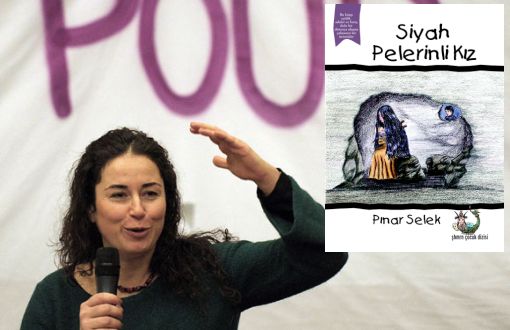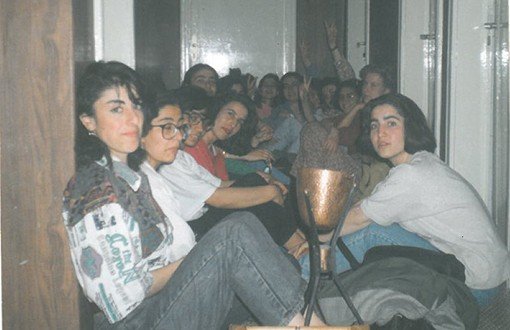When we ask “How much do fairy tales mean for children?” one of Alberto Godenzi’s finding about sexual abuse comes to my mind: “Women secretly want to be raped.” How could men think like that? “Many books and films show that how the woman’s first resistance turns into pleasure immediately,” (page: 116). We can find the origins of negative myths -primarily rape myths- in so-called innocent fairy tales. You can find it exaggerated; read any fairy tale carefully and you’ll agree with me.
Does the solution mean erasing all of the fairy tales? Maybe. The solution can be rebuilding fairy tales with being sensitive to social gender by destroying their old structures. Melek Özlem Sezer calls it “Anti-fairy tale”. She states that anti-fairy tale aims to focus on social gender, to destroy the stereotypical structure and to move reader far away from the old text by making him/her interrogate the given messages.
I met a book named “Siyah Pelerinli Kız* (Black Cloaked Girl)” by author Pınar Selek while searching for anti-fairy tales. The book was published by Şahmaran Women’s Solidarity and Research Center in 2009 along with a series of thirteen children’s books.
Siyah Pelerinli Kız’s location is Midye Island. The only obstacle for the island to be in bed of roses is a black veiled witch. She is a familiar witch. “As it’s being told, she comes from the depths of the earth. From the underworld. Her teeth are black and her claws are forty inches long. Her purpose is saddening people.” (Page: 8-9)
Why are all the witches female? Why are they ugly? Why do they live in unknown and far places?
The fiction of the book is common. Women off the charts are witches and they live isolated places in the depths of the earth. However, there is a problem. Black veiled witch attacks grooms. It is the deadlock of the book. Grooms in fairy tales are usually strong and they are princes. They defeat evil witches and dragons and they undergo perils and mysteries to reach their brides but in this fiction, grooms are beaten by the witch. Grooms have black eyes when the wedding time comes up. So, the cliché wedding image is upside down.
The protagonist of the book is a little girl named Yosun. Yosun’s brother is also beaten by the witch before his wedding day. “My brother was alone at home. When he would come out of the house, the witch came and beat him with her broom without saying a word. Beat and beat..” (Page: 10).
Yosun thinks about why the witch beats only grooms.
The little girl decides to look for the black veiled witch in order to find answers. She starts the job with her school mates when the school finishes. “My friends got bored with searching. They got thrilled at first but they lost their interests. Some of them were afraid. Eventually, my family understood we were searching the witch. They told spooky tales and forbade us from wandering around,” (Page: 14). The decisive little girl, Yosun, gets alone. Other people start to search the witch, too but they are usually males. Yosun’s family gets angry with her. They do anything to deter her. The little girl is reminded the gender roles of the society: “You are being a tomboy,” (Page: 15).
“We couldn’t dream without seeing nightmares,” (Page: 18) says Yosun and she defies the traditional structure built upon the fear and hits the road alone. She ends up in a forest where is a place women should keep away from; a place filled with fear and unknown. At the same time the forest is a place where fearless women get stronger embracing with the woods. The little girl listens to her heart and enters the forest with courage. The evening falls. She leans on an oak tree with fear and the tale continues with a different path. A second upside down. The oak tree talks and makes Yosun calm down. The tree knows why Yosun has come to the forest but asks Yosun why she has come. Little girl's aim is to reveal the truth. When oak tree trusts the girl since she behaves according to the truth not the patriarchic revenges, it tells where the witch lives.
Another upside down for Yosun: “The witch is too young. She has very long and very dark hair. How sleek… The witch holds not a broom but a baby. She caresses, kisses and loves the baby! I saw a bright thing among her hair. Upon her back. Not a hairclip not an ornament but a knife!” (Page: 25-26-27).
That witch doesn’t match with cliché witches. Who is that witch? The oak tree tells the truth:
Once upon a time, there was a young girl who was living in an island. Island people called her the Black Cloaked Girl due to her very dark and very long hair. She was poor with her fisher family and eight siblings. Her mother died while giving birth to her last child. Black Cloaked Girl loved a fisherman like her father. However, her father didn’t allow her to marry a beloved man but made her marry a wealthy man, instead. Black Cloaked Girl got very upset and shy. One day she went to the sea shore and waved at the boats in the sea by calling out her lover’s name. The girl’s husband got furious and stabbed her. He assumed that she was dead and dragged her to the forest by covering her with soil.
The telling of oak tree matches with patriarchic purity concept. The rest of the story makes you question that patriarchic purity and brings it down.
Black Cloaked Girl heals with the help of a forest fairy and she gets pregnant with the magic of the fairy. She gives birth but cannot breastfeed her baby due to the knives in her back. Knives prevent her from breastfeeding. Mother and the baby never age. Black Cloaked Girl gets angry with the pain because she cannot feed her baby. So, she starts to attack grooms. Her pain is fed by her rage. There is always an antidote according to the forest fairy. The love of a human is needed to break the spell but not a common love. That love needs solidarity with other women who are abused and exposed to violence.
Did Yosun save the Black Cloaked Girl from her knives? Was Black Cloaked Girl freed by overcoming her rage?
These questions constitute the end of the tale. Yes, the tale ends with a happy ending but not with a common one. The happy ending comes with the “antidote”.
I hope anti-fairy tales will increase and I hope our children will meet Black Cloaked Girl by Pınar Selek. Enjoy reading! (ED/HK)
* Pınar Selek, "Siyah Pelerinli Kız", Şahmaran Kadın Dayanışma ve Araştırma Yayınları.(Pınar Selek - Black Cloaked Girl - Şahmaran Women’s Solidarity and Research Center)
Click here to read the article in Turkish






